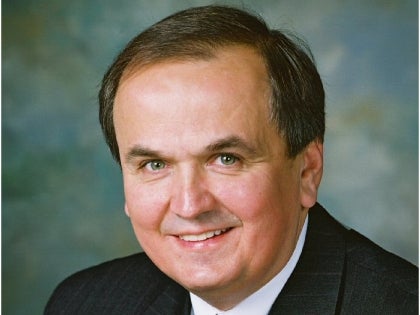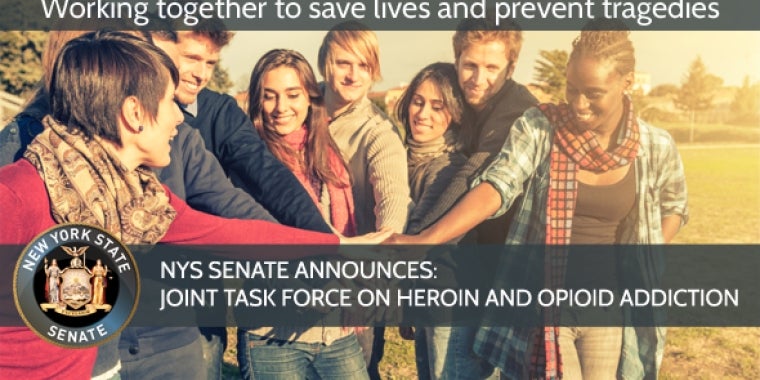
Senator Maziarz named to new Task Force on Heroin and Opioid Addiction
George D. Maziarz
March 17, 2014
-
ISSUE:
- Health

Senator George Maziarz (R-C, Newfane) today announced the creation of the Senate Task Force on Heroin and Opioid Addiction to examine the rise in use of heroin and other opioids in New York State and develop recommendations for treating and preventing addiction. Senator Maziarz will serve as a member of the Task Force.
“Heroin remains one of the most dangerous and addictive drugs on the streets today,” Senator Maziarz said. “It ruins lives, destroys families, and impacts our society in countless ways. I am happy to be part of this collaborative new effort to reduce heroin use.”
The bipartisan task force will be chaired by Senator Phil Boyle (R-C-I, Suffolk County), Chairman of the Senate Committee on Alcoholism and Drug Abuse. He will be joined by task force Vice-Chair David Carlucci (D-Rockland), Chairman of the Senate Committee on Mental Health and Developmental Disabilities, and Vice-Chair Michael Nozzolio (R-C, Fayette), Chairman of the Senate Codes Committee. Members will examine the issues and solicit input from experts and other stakeholders about addiction prevention and treatment options, the rise in heroin and opioid use, and the potential for drug-related crimes and other negative community impacts. The task force will then develop recommendations which will be used to draft legislation to address the issues raised.
The task force will hold forums in communities across the state to solicit input from stakeholders and experts and use the information collected to develop recommendations for legislative action.
In the Senate’s budget resolution passed last week, $5 million was proposed for increased heroin prevention, treatment, and recovery support services. The resolution also included a measure to increase the penalties for drug dealers by making it a class B felony for anyone to possess 50 or more individual packets of heroin and/or an amount of heroin with an aggregate value of at least $300.
The task force announced today will also examine the crimes that accompany increases in illegal drug activity. In February, the New York Times reported that the federal Drug Enforcement Administration’s (DEA) heroin seizures in New York State increased 67 percent over the last four years. The DEA’s New York office “seized 144 kilograms of heroin, nearly 20 percent of its seizures nationwide, valued at roughly $43 million.”
Heroin’s deadly affects are well established, and overdoses are on the rise across the state. Data released by Newsday reported that heroin “killed a record 121 people in Nassau and Suffolk in 2012 and at least 120 last year -- the two highest totals ever recorded.” The Buffalo News reports that 29 people died of heroin overdoses in Erie County in 2013, “almost a third more than the year before.” The Syracuse Post Standard reported that heroin-related deaths “have climbed rapidly in Onondaga County -- from two in 2010 to 24 in 2013.” In New York City, the Times reported that “after several years of decline,” heroin-related overdose deaths increased 84 percent from 2010 to 2012.
Some experts have pointed to the enactment of I-STOP, a state law to curb the abuse of prescription opioids and other drugs, as one factor in the dramatic increase in the number of heroin users across New York in recent months. As prescription painkillers became more difficult to obtain and more expensive when sold illegally, individuals turned towards heroin because is it often cheaper and/or more easily obtained and provides a high similar to prescription opioids.
A 2012 federal survey on drug use and health reported that the number of people who said they used heroin in the past 12 months rose from 373,000 people in 2007 to 669,000 people in 2012. The agency also reported that the number of people dependent on heroin rose, from 179,000 people in 2007 to 369,000 people in 2011.
According to the National Institutes of Health (NIH), in 2011, 4.2 million Americans aged 12 or older (or 1.6 percent) said they had used heroin at least once in their lives. The NIH estimates that approximately 23 percent of individuals who use heroin become dependent on this highly addictive drug.
Additional members of the joint task force include: Senator Greg Ball (R-C-I, Patterson), Senator John Bonacic (R-C-I, Mount Hope), Senator Pat Gallivan (R-C-I, Elma), Senator Martin J. Golden (R-C-I, Brooklyn), Senator Joseph A. Griffo (R, Rome), Senator Kemp Hannon (R, Nassau), Senator William Larkin (R-C, Cornwall), Senator Betty Little (R-C-I, Queensbury), Senator Carl L. Marcellino (R, Syosset), Senator Kathleen A. Marchione (R-C, Halfmoon), Senator Jack Martins (R-C-I, Mineola), Senator Patty Ritchie (R-C, Heuvelton), Senator Joseph Robach (R-C-I, Rochester), Senator Diane Savino (D, Staten Island/Brooklyn), Senator James L. Seward (R-I-C, Oneonta), and Senator Cathy Young (R-I-C, Olean).
#####
